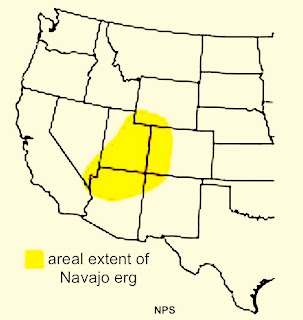 |
Red Canyon off Highway 28 south of Lander, Wyoming. Scanned slide; original from 1986.
|
“Once upon a time, you took a picture of something that lots of people photograph. However, because you are a geologist, it didn’t turn out the way it does for most people. Show us that picture, tell us what you see in it, and tell us about the way you take pictures.”I bet almost everyone who stops for a photo at Red Canyon Overlook sees an eye-catching landscape composed of the eponymous red slopes of the Permo-Triassic Chugwater Formation. Not me. I see the Nugget sandstone -- the pale cliff-former above.
The Nugget is equivalent to the much-more-famous Navajo sandstone -- the lithified remains of a huge erg that was perhaps the largest dune field on earth ever. Wyoming lies at the eastern edge of the ancient erg, and the Nugget is pretty wimpy compared with the massive exposures of Navajo in southern Utah for example. Outcrops at Red Canyon are on the order of 30 feet high.
 |
| Wyoming is on the edge of the early Jurassic Navajo erg; courtesy NPS. |
Truth is, I’m not “really” a geologist, in spite of my passion for the subject. I’m a botanist; my interest in the Nugget has to do with plants. What I see at Red Canyon Overlook is habitat for Barneby’s clover, a plant endemic (restricted) to the southeast foothills of the Wind River Range and nearby Beaver Rim. That’s right ... it grows nowhere else on earth! In 1986 I had the pleasure of five days of wandering through scenic rock gardens where this clover thrives.
 |
| Map courtesy WYNDD (modified). |
 |
| Photo by Charmaine Refsdal. |
Andrew asks about "the way you take pictures.” In 1986, I put slide film in the Pentax K1000, pointed it at the subject, adjusted camera and lens, carefully framed the shot in the viewfinder, and hoped for the best. I was after close-ups of plants, and shots showing various aspects of habitat -- sometimes from close by, sometimes from far away. Towards those ends my Vivitar Series 1 Macro-focusing 28-90 mm lens was wonderful.
Now I use an upper-end point-and-shoot, a Canon PowerShot A720. It too is wonderful in its own way -- light, easy to use, many manual adjustments possible. Perhaps the best thing is that I now can afford to take lots of shots. I experiment, put more effort and thought into composition, and get better results overall. But I really miss the ability to compose in a viewfinder. Too often when it's sunny I can't even find my subject in the monitor of the Powershot. What do I see? ... not much!
Now I use an upper-end point-and-shoot, a Canon PowerShot A720. It too is wonderful in its own way -- light, easy to use, many manual adjustments possible. Perhaps the best thing is that I now can afford to take lots of shots. I experiment, put more effort and thought into composition, and get better results overall. But I really miss the ability to compose in a viewfinder. Too often when it's sunny I can't even find my subject in the monitor of the Powershot. What do I see? ... not much!
Scanned slides courtesy Wyoming Natural Diversity Database; modified in iPhoto to reduce intense highlights and neon tones.



that's a beautiful picture! I love the red slopes and teh story behind them! :-)
ReplyDeletethanks, EE
DeleteAndrews post led me here. Gosh, he knows a good thing when he see's it! Thank you for your very interesting and informative insights.
ReplyDeleteThank you! for visiting and for the compliment, much appreciated.
Delete